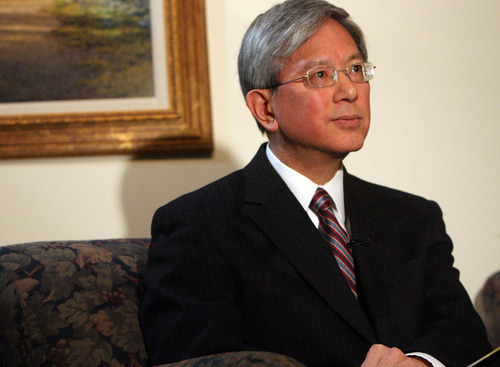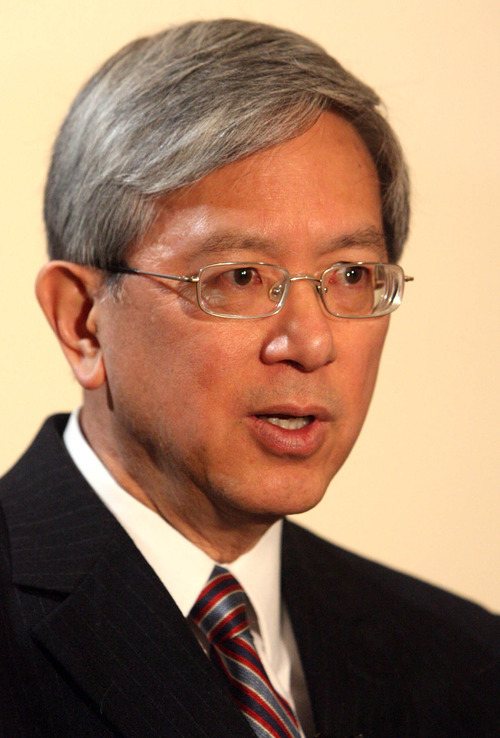This is an archived article that was published on sltrib.com in 2011, and information in the article may be outdated. It is provided only for personal research purposes and may not be reprinted.
The LDS Church is doing away with congregations exclusively for students and replacing them with "young single adult" wards throughout Utah, a Mormon general authority said Thursday.
Perhaps the most significant change is that those wards, which include some 150,000 Utah Mormons between the age of 18 and 30, will then become part ofmuch larger all-singles stakes.
"We want every young single adult to know who their bishop is and every bishop to know who they are responsible for," said Elder Gerrit W. Gong, a member of the church's First Quorum of the Seventy. "But we also want to provide larger units of sociability."
Scott Perry, bishop of a young single adult (YSA) ward in the Kearns area, is delighted with the change.
For one thing, Perry sees the new program as equalizing the size of singles wards. Rather than maintaining student wards with upward of 500 members — or wards with only 50 such as his — the optimal number in the future will likely be about 100.
Bishops of student wards have been "handicapped in what they can do," Perry said Thursday, "because there are just too many young people [in the ward] to serve adequately."
He also hopes it will stem the tide of "wandering" young people who "ward hop," going from place to place, rather than becoming involved in a particular ward.
That was part of the impetus behind the move, Gong said.
"We are going to invite young single adults to choose one of two options: remain in their home [family] wards, or attend the young single adult ward to which they are assigned," he said. "We will be careful to be welcoming and not turn anyone away, but we hope they will stay in their own unit."
In the future, some LDS buildings, which currently house singles wards and several family wards, will have only singles wards. Young people can mingle in the hallways and after services with singles from the other wards. These singles wards may also stage joint activities with sister wards, the whole singles stake (typically made up of eight to 10 wards) or with multiple stakes.
Perry is eager to see how it works to have all-singles stakes, which will have joint activities to expand the singles' range for friendships, dating and service opportunities.
"That's a new concept for us," he said, adding that he envisions it providing more leadership opportunities to the younger generation.
"The more this age group has the ability to be together and to teach each other — almost govern themselves within their age group," he said, "I think that's going to train leaders for the future of the church quicker."
The biggest change may be in Utah County, home to LDS Church-owned Brigham Young University and 66,000 young single adult Mormons. In the past, only those attending college were assigned to student wards on campus. Now everyone in that age group will be part of YSA wards, whether they are students or not.
University of Utah student Brittney Lopez tried going to a singles ward in her own Orem neighborhood last year, but she found it filled with people from her high school.
"It wasn't fun," Lopez said. "When seeing the same people, a singles ward is not doing what it's supposed to do — give you new people to meet."
And marry.
This move goes hand in hand with speeches by LDS President Thomas S. Monson and other leaders at last weekend's General Conference, urging young men and women to stop postponing marriage, which is, after all, the goal of the singles wards.
"A central purpose of these [service, learning and social] activities is to help young single adults find marriage partners and prepare to marry in the temple and raise righteous families," says the church's new Handbook 2 in its guidelines for ministering to single Mormons age 18 to 30.
Though the move was announced in Salt Lake City wards Sunday, with an invitation for all young Mormon singles to attend an event at downtown's LDS Conference Center for a full explanation, it's already under way in Logan and St. George.
In those areas, Gong said, LDS leaders have seen positive effects.
"Some of those who have been less involved now have come back," he said. "We want everyone to feel that there's a place for them."
Programs such as this one have come and gone to meet the changing needs of this and every other LDS cohort — changes may come again in the future.
"No one would say this is the organizational end point," Gong said. "It's just part of the journey."
LDS men delaying marriage?
LDS leaders are pressing anew for young Mormon men to stop delaying marriage. The reasons for cold feet range from fear to finances to finickiness. Read about this trend and what some say should be done about it. • http://www.sltrib.com







